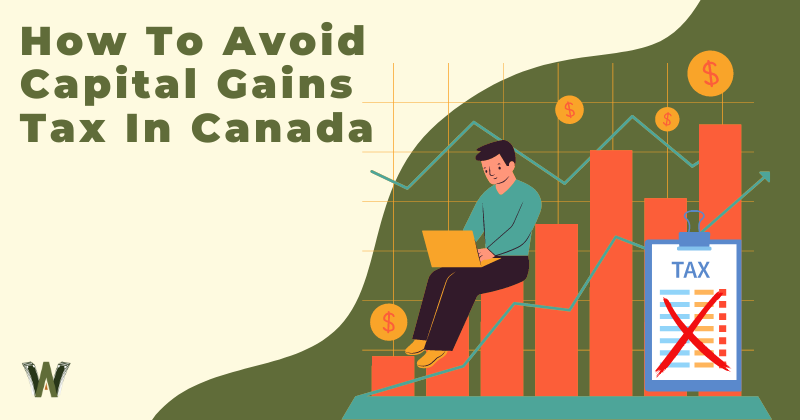Do you own assets that have appreciated significantly in value since you purchased them?
Selling these assets at a large profit can result in significant capital gains taxes in Canada.
Although a capital gain is the most efficient type of investment return, 50% of the total capital gain is still taxed at your marginal tax rate.
In a lot of cases, it makes sense to do a little bit of tax planning and defer (or avoid) paying too much capital gains taxes in any one particular year.
I will cover how to avoid capital gains tax in Canada below and go over five approaches that you can take to assist with your tax planning.
Realized versus Unrealized Capital Gains
Capital gains start building up within an asset as soon as it increases in value beyond its initial purchase price. You can find capital gains across many different asset classes, including:
- Stocks
- Exchange-traded funds or mutual funds
- Real estate
- Collectibles
- Bonds (from price appreciation)
Assets that have appreciated in value but are still owned have embedded unrealized capital gains. There is no tax implication for continuing to own an asset that has increased in value in almost all cases in Canada.
50% of capital gains are taxed at your marginal tax rate in the specific year you choose to sell an asset at a profit. This is considered a realized capital gain.
How to Avoid Capital Gains Tax in Canada: Five Ways
1. Deferring Capital Gains

The simplest and easiest way to avoid paying capital gains at any particular time is to defer selling the asset that has appreciated in value further into the future. This is an especially important concept if you have some sense of what your future income levels will look like.
Remember that 50% of capital gains are added to your income for the year and taxed at your marginal tax rate. If you are expecting your income in future years to be lower than it is today, it may be extremely valuable to defer realizing the capital gains (or selling the asset) until you are in a year with lower income.
If you instead feel that your future income each year will continue to increase, it may make sense to consider outright selling the asset now. This is especially valuable if you are not in the top income tax bracket as of right now.
Another option is to break up the selling of the asset into smaller portions, which mainly applies to assets that can be broken down into smaller units. This can include stock shares, ETF units, and more.
Realizing a smaller amount of capital gains over many years may help you to avoid reaching higher income tax brackets. If you are already being taxed at the highest marginal tax bracket, whether you sell smaller portions or the full asset should incur the same tax implications.
If you urgently need to liquidate one or more assets that have embedded capital gains, this approach will not work for you.
2. Take Advantage of Tax-Preferred Accounts

Tax-preferred accounts are another approach to reducing how much you are paying in capital gains taxes. Tax-preferred accounts offer investors an account type that is superior from a tax perspective relative to a regular non-registered investment account.
There are two main types of tax-preferred accounts to understand: tax-deferred accounts and tax-exempt accounts.
Tax-Deferred Accounts
Tax-deferred accounts include accounts that allow you to avoid paying taxes up-front and defer the taxes being paid until the money is withdrawn from the account. In Canada, a well-known example of a tax-deferred account is the Registered Retirement Savings Plan, or RRSP.
Contributions to an RRSP account reduce your income for the year by the contributed amount. This allows you to avoid paying income tax on your contribution in any given year. Once the RRSP is opened, you can invest your money in a wide range of investment asset classes.
Withdrawals that you make from an RRSP are taxed as income in that particular year.
Since the RRSP is tax-sheltered, any transactions within the RRSP do not have tax implications. This means that you will not incur capital gains when selling assets at a profit. You have a lot of flexibility when it comes to trading in an RRSP or other similar tax-deferred accounts.
Tax-Exempt Accounts
Tax-exempt accounts include accounts that allow you to completely avoid any tax implications when trading in the account or when taking money out of the account. In Canada, a well-known example of a tax-exempt account is the Tax-Free Savings Account, or TFSA.
Contributions to a TFSA are done from after-tax income, meaning that you have already paid taxes on the money that is being contributed to the account. Trades within a TFSA have no Canadian tax implications and you will not have to worry about any capital gains.
Withdrawals from a TFSA are not taxed as income, unlike withdrawals from an RRSP.
As an excellent investment account option in Canada, the TFSA is superior to the non-registered account in almost every way imaginable. If you are not currently investing within a TFSA, make sure to explore your options.
Be sure to read my TFSA vs RRSP guide for a more in-depth breakdown of both account types.
3. Offsetting Capital Gains with Capital Losses

Capital losses, or the selling of specific investment assets at a price below what they were purchased at, can be used to offset capital gains for the year. You can entirely offset capital gains or only partially offset capital gains.
As an example, if you have a $5,000 capital gain and a $5,000 capital loss in a given year, you will not be responsible for any capital gains tax for the gain.
Capital losses can be carried back up to three years, which can be used to offset capital gains that you have paid taxes on in the past. Capital losses also build up and can be carried forward for any period of time.
Using capital losses to offset capital gains in order to reduce capital gains tax is a strategy that is known as tax-loss harvesting.
Keep in mind that you can’t quickly sell and re-buy an investment in order to trigger a capital loss. The losses used to offset capital gains have to be real capital losses.
Be sure to read the CRA’s article on using capital losses for more details about this approach to avoiding capital gains tax.
4. Donating Investments Directly to a Charity

If you are someone that frequently donates to charities, you may want to consider donating stocks, especially those with large capital gains, instead of cash going forward. You can even choose to donate other investments, including:
- Mutual funds
- Segregated funds
- Government of Canada or provincial bonds
Donating an investment with built-in capital gains eliminates the capital gains tax for you. You will also usually receive a donation tax credit, which will reduce the income taxes that you are responsible for at year-end.
Donating investments is a fairly complicated process – make sure to do additional reading on the subject for more information.
5. Take Advantage of the Lifetime Capital Gains Exemption (LCGE)

Small business owners may be able to take advantage of the lifetime capital gains exemption (LCGE) that is offered by the Canadian government. This benefit applies to specific qualified businesses, which typically include small business corporation shares, qualified farm property, or qualified fishing property.
As of 2023, the LCGE is $971,190, an increase of $57,560 from 2022.
Although the LCGE is fairly selective in terms of which capital gains taxes it helps to eliminate, it can eliminate an incredible amount of capital gains tax if you are selling a business that qualifies.
Before being able to qualify for the LCGE, you must have owned the private shares of the company for at least two years prior to the sale. Make sure to consult your accountant to learn more about taking advantage of the lifetime capital gains exemption.
You can also read more about the LCGE on the Government of Canada website.
Frequently Asked Questions
How to Avoid Capital Gains Tax on Rental Property in Canada?
If you have a rental property in Canada, it will be extremely difficult to avoid capital gains tax. Capital gains taxes can usually be avoided only on primary residences which have been your home each year since owning them.
One way to avoid capital gains tax on rental properties is to avoid selling them altogether – simply continue renting them out.
Conclusion

If you own one or more investment assets with embedded capital gains, you will likely look for ways to avoid paying too much capital gains tax.
Many strategies exist when it comes to reducing how much capital gains tax you pay in a given year. Some approaches are better suited for specific types of investment assets than others.
In almost all cases, you will eventually have to pay capital gains taxes at some point down the road. The timing of your capital gains tax payments can be just as important as how much you are paying.
If you want to learn more, be sure to read my article on capital gains tax in Canada.




